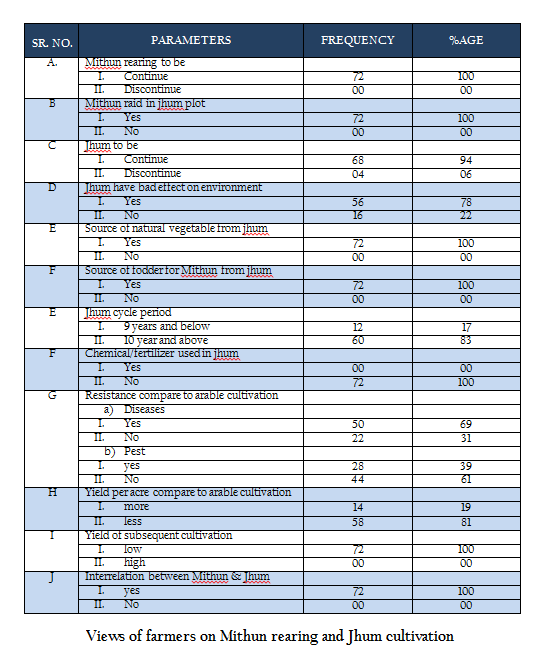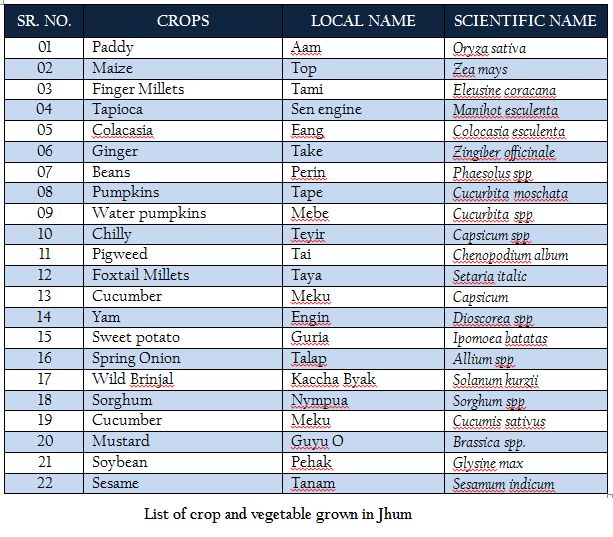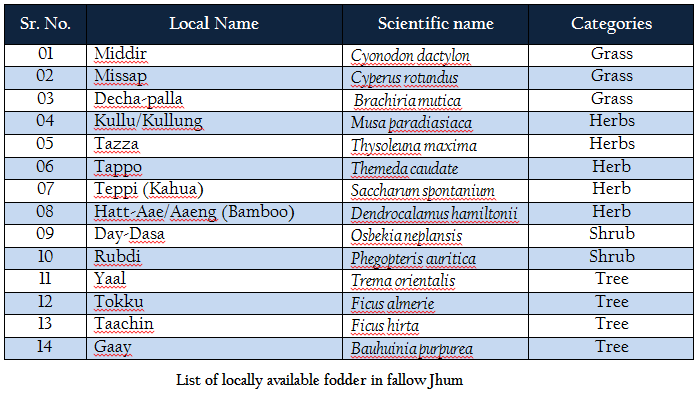Advances in Animal and Veterinary Sciences
Research Article
Advances in Animal and Veterinary Sciences. 2 (1): 15 – 19Assessment on Mithun, Jhum and their Interrelationship in Tribal Inhabitant Area of Papum Pare District, Arunachal Pradesh, India
Tilling Tayo1*, Tadang Meena1, Taba Heli1, Neeta Longjam2, Vivekananda Safi1, Tilling Tabyo1
2. KVK– East Siang, Central Horticulture and Forestry College, Pasighat Arunachal Pradesh, India
*Corresponding author: tilling.tayo@gmail.com
ARTICLE CITATION: Tayo T, Meena T, Heli T, Longjam N, Safi V and Tabyo T (2014). Assessment on mithun, jhum and their interrelationship in tribal inhabitant area of papum pare district, Arunachal Pradesh, India. Adv. Anim. Vet. Sci. 2 (1): 15 - 19.
Received:2013–10–31, Revised:2013–11–08, Accepted: 2013–11–10
The electronic version of this article is the complete one and can be found online at (http://dx.doi.org/10.14737/journal.aavs/2014.2.1.15.19) which permits unrestricted use, distribution, and reproduction in any medium, provided the original work is properly cited
Abstract
Study aim to explore the Mithun, Jhum and their interrelationship and farmers views regarding the age old practices, which is still sustained in rural area. Mithun rearing and Jhum practices have synergistic interrelationship, as Jhum provides fodder to mithun conversely mithun provides manure to Jhum plot. Jhum is a source of more than 22 varieties of crops and vegetable apart from fodder for mithun. Mithun raid in Jhum is very common unless protected with strong fence. However, Mithun being the choice animal and Jhum being source of food security, the practices of Jhum integrated with Mithun is preferred by each and every farming community of Mithun rearer and Jhumias, which is the main reason behind why still they are stick to the traditional old system of Mithun production and Jhum cultivation
Introduction
Mithun (Bos frontalis) a unique bovine species found exclusively in the four states, Arunachal Pradesh, Nagaland, Manipur and Mizoram of North East India and in parts of Bhutan, Myanmar, China and Bangladesh (Chaurasia et al. 2010). Arunachal harbor a major chunk 82.84% (2, 18,931) of Mithun population of India followed by Nagaland (12.63%), Manipur (3.79%) and Mizoram (0.73%), (Livestock census 2007). Especially, Tani clain (Apatani, Adi, Galo and Nyshi) of Arunachal tribes have socio–culture and emotional relation with Mithun and consider not just like other livestock but as special animal blessed by Lord Donyi Polo (God). They are considered as yardstick of wealth calibration and instrument of peace and settlement in tribal community. Mithun are reared in free range system in semi wild domesticated form until used either for food on festive occasions, victory celebration, marriage feasts, barters purpose and rituals sacrification or sell at the time of adversity condition (Tayo et al. 2013).
On the other hand Jhum practices in the tribal area of Arunachal Pradesh is as old as beginning of human towards agriculture activities for the search of food security to have sustainable source of food (especially rice) supply to the family, community and village as a whole. A Jhum activity starts with the earmark of dense forest by Jhumias followed by slashing of forest canopy during pre–monsoon period and is usually allowed to dry for couple of weeks then whole slashed material is burned and before the onset of monsoon, the Jhum plot is prepared for sowing. With the onset of monsoon, according to the Jhumias choices of crop and vegetable to be grown are put in the field and harvest during winter period. Many researchers have been criticized about Jhum practices in tribal belt especially in North east part of India due to its degrading effect on environment and ecology of the region (Parag et al. 2010). Different government department aimed at providing an alternate source of livelihood to the Jhumias and rehabilitating the degraded Jhum lands, but the result of many of these programs have been far from satisfactory. Either the scheme were not continued for sufficient long period of time to make the Jhumias self reliant by providing them an assured livelihood add and the schemes lack of adequate technical support (Vishal, 2005). It has been seen that the Mithun rearing in Arunachal Pradesh is closely associated with Jhumias and vice versa and the system of practices is followed since time immoral. So, the present study was envisaged to study the relation between Mithun production and Jhum practice and the farmer views regarding the age–old practices, which is still continuing in rural area of Papum Pare district of Arunachal Pradesh.
MATERIALS AND METHODS
The study was conducted in 2013 in Papum Pare District, the capital district of Arunachal Pradesh is located between 26º 55´N and 28º 40´ latitude and between 92º 40´ and 94º 21´ longitude. Papum Pare district is bounded by Kurung Kumey district in the north, Lower Subansiri district in the East, East Kameng district in the west and Assam in the south. Total geographical area is 2875 sq km harboring 10560 numbers of mithun populations and area under Jhum is 259.73 sq km. Altogether, 74 framers were interviewed to collect the Mithun and Jhum information. The traditional knowledge and the associated information were collected from the elder generation with the prior informed consent (PIC). Various types of participatory research tools, key informer surveys and site observation were done to collect the specific information on Jhum and Mithun practices a questioner has been designed. And a respondent’s answers and views were further recorded in a uniform prepared questioner of each individual sheet. The data were analyzed with the help of frequencies and percentages.
RRESULT AND DISCUSSION
PCR for PCV2 Detection
The perception of respondents through interview and self–observation methods is given in the Table 1.
Mithun Rearing to be Continued/Discontinued
All the respondents were willing for Mithun rearing to be continued on religious, social and economic ground since Mithun is the ‘Choice animal’ to be sacrificed during religious rites, festivals and other social occasions (community feast, victory celebration and dispute settlement). From economic point of view they are use in paying bridal price apart from fulfilling the money requirement for medical treatment and education of children, where the money involvement cannot be compromised. So they consider mithun as a last resort of money. This finding has been further supported by Otem (2012). Mithun helps in poverty alleviation, the landless poor framer can look after the other Mithun in tenants system, in which every after two calving the third calf is given to tenant.
Mithun Raid in Jhum Plot
Cent percent said one of the major problems in Jhum cultivation is Mithun raid, often Mithun raid the field if the fence is not strong enough to resist the attempt made by mithun to entry into Jhum plot. Similar finding was observed by Tayo et al (2013). So, before start cultivating Jhum they make strong fence with available wood or bamboo around the Jhum plot to ensure protection of crop from mithun and other animal.
Jhum to be Continue/Discontinue
Jhum activities start with burning and clearing of forest to harvesting of crops as shown in Figure 1 and Figure 2 respectively. Majority of farmer (94%) have an opinion that Jhum should be continued because most of the tribal inhabitant areas are dominated by hilly terrain and wet land paddy cultivation isn’t possible. In order to cater the need they have to follow Jhum system on need base agriculture activities considering the strategic physo–topography of local area. It optimizes the land use pattern of agriculture by growing as many as 22 varieties of crop and vegetable (Table 2) at a time in same plot, which fulfils the basic needs of farmer from same plot and minimize the dependency on external inputs except for fruit. Further recent researcher have shown that Jhum help to maintain ecological diversity and does not causes widespread destruction of the top soil as was originally perceived (Das, 2006). However six percent of farmers have the view that Jhum should be discontinued and alternative farming system should be adopted by Jhumias in near future, since it takes few days to cut down all the vegetation ear mark for Jhum, where as it take 8 to 12 year to get the same vegetation.
Jhum on Environment
Majority of farmer (72%) have the view that Jhum practices have bad effect on environment in long run, since it has been noticed that Jhum cultivation near the stream or water source had adverse effect on water availability in subsequent year and sometime the water source dries up completely. So, Jhumias of Leptap area bind a rule within their community not to practices Jhum near natural stream or water bodies. Similarly Jha et al., (1976) Primentel et al., (1987) and Ausubal (1991), found that, it has adverse environmental impacts, include contribution towards green house gases, drying up of few available water holes, hill streams, rivulets and rivers in the hilly terrain. It also causes reduction in the water retention capacity of the soil, soil erosion, lose of soil nutrients, massive landslides and even land sinking. However, 28 % respondent said majority of land (80.43%) in Arunachal Pradesh is covered by forest, practicing Jhum in acre of land doesn’t have any detrimental effect on environment and instead it has a role in rejuvenation of forest.
Source of Natural Vegetable
100% farmers said, fallow Jhum plot is a hub for natural vegetable source; it also contributes towards conservation of agrobiodiversity, particularly the germplasm of many local crop and vegetable varieties shown in Table 3.
Source of Fodder for Mithun from Jhum
Jhum field is a good source of fodder and feeds for cattle, pig and goat that in turn decreases pressure on pastoral land (Murtem et al. 2008). cent percent farmer said on the fallow Jhum plot different types of fodder are grows in high density in subsequent year (Table 4), over which Mithun graze and pass urine and dung while grazing in the area, as a result it increase the fertility of soil in following year and more fodder grows over it until the growing tree over it are dense enough to discourage the fodder growth.
Jhum Cycle Period
83% of respondent said jhum cycle is 10 years or above, with the support that in olden days there was no any recording system of birth date, as parents were illiterate, so the age of son/daughter were certain by the Jhum cycle, taking it as an average of ten (10) years/Jhum cycle.
While 17% said Jhum cycle is 9 year or below, Jhum cycle length vary from place to place depending upon the location and topography of Jhum plot. Very steep with rocky area adjacent to Jhum plot will take longer Jhum cycle compare to moderate steep with natural vegetation adjacent to Jhum plot, since natural source of raw material for vegetation are not available at disposal distance at former case.
Chemical use in Jhum
Unequivocally cent percent farmer said chemical such as pesticide, insecticide and fertilizer are never used in the Jhum area. This finding was opined by Paul (2008), because slashing and burning the matter helps enrichment of soil with sufficient nutrient to support the growing crop or vegetable over it. On public health point of view also the crop or vegetable produce in Jhum area is better as product is cent percent free from other inorganic chemical.
Disease and Pest Resistant Compare to Arable System
It has been observed that Jhum plot have better bacterial and viral disease resistance capacity compare to arable cultivation. Majority (75%) of respondent are of opinion that due to destruction of their favorable environment for soil borne pathogens multiplication due to heating or antiseptic property of the smoke formed while burning of slashed matter might be the reason or naturally they are resistant to disease. Similarly, Murtem et al, (2008) found that, the local germplasm of paddy, cucumber, millet, bajra, maize, pumkin, chillies etc. are known to have high resistance to insect and diseases. However, 25 % said presence of white grub is most common in Jhum field if control measure is not taken by mechanical removal and destroyed. Otherwise the entire crop gets destroyed by soil born single insect.
60% of farmers said the pest attack is more common in Jhum area compared to arable cultivation especially vertebrates pest like rat and birds are very common, apart from other wild animal because majority of Jhum are practices in deep forest near the dwelling area of predators that makes them convenient to visit frequently and attack on standing crop of Jhum plot.
Yield per Acre Compare to Arable Cultivation
Majority of farmer (81%) said that yield per acre of Jhum is lower than arable crop cultivation since nutrient for crop is solely depend from the burn vegetation and more over during heavy rain most of the fertile top soil are washed away making nutrient availability at limited level for the crop. However, 19% respondent said yield of crop from Jhum are more compare to arable cultivation and it also vary from place to place depend upon the fertility of soil. The Jhum plot with very thick vegetation at the time of slashing and burning will yield higher than arable per acre yield and vice versa.
Yield of Subsequent Cultivation
Cent percent of the farmer said subsequent cropping in Jhum plot have lower yield as compare to first cultivation cycle, because of hilly terrain topography the nutrient and minerals are washed away by the rain and erosion. So the Jhumias leave the plot after the end of harvest and search for another fresh plot bearing good number of vegetation. However, the yields of subsequent cultivation in Jhum land are directly related with the thickness of vegetation at the time of cutting or slashing in Jhum plot, thicker the vegetation, higher the yield and vice versa. So depending upon the parameter of vegetation thickness at the time of slashing and burning, Jhumias go for subsequent cultivation in next year other leave as such.
Interrelation between Mithun and Jhum
Mithun being reared in free–range system in semi wild domesticated form, they travel for long distance in search of fodder as they are selective browser and consume more than 30 kg in a day depending upon to their body weight. One of the most problems in Mithun husbandry practices is to trace them in forest (jungle) as they travel length and breadth of forest in search of fodder, mean while sometime they become pray to the wild beast. Thick forest is boon for environmentalist conversely it is bane for Mithun rearers, as thick forest harbours very less fodder for mithun except for few area, where sunlight and air is passed freely. However, fallow Jhum plot is boon for the Mithun rearers as fodder are grown in high density and Mithun have natural preference to fodder grown in Jhum plot as compared to fodder grown on other plot and it is hypostasized that due to tenderness and presence of higher mineral especially sodium and chlorine in the fodder grown in fallow Jhum, might be the reason, as mithun exhibit naturally extra salt hunger behavior, so Mithun can be tamed by offering common salt (Rajkhowa et al. 2004). On the other hand owner need not travel long distance to spot their Mithuns so, most of the Jhumas are Mithun rearers and they would like to continue Jhum practice in different pocket off course in small area, not only for food security but also for fodder security of Mithun.
CONCLUSIONS
Mithun rearing and Jhum cultivation have an age–old inter–relationship for the farming community of Arunachal tribes: as Jhum and Mithun are mutual benefitted by sharing fodder and manure. Mithun and Jhum are like two different facet of same coin that have imprinted deeply in socio – culture and economy parameter for rural livelihood. So, it is very difficult to wean existing Mithun rearing system or Jhum practices from the heart and minds of farming community (Mithun rearers and Jhumias) at present scenario, unless fodder security for mithun and food security for farmer are assured by state or central Government.
REFERENCES
Tayo T, Heli T, Atul B, Gama N (2013). Mithun Husbandry – Issues and Strategies in Papum Pare District of Arunachal Pradesh. J. Kri. Vigyan., 2: 56–59
Chaurasia RK, Mech A, Dhali A, Vidyarthi VK, Rajkhowa C, Sharma V B (2010). Effect of Altitude and Season on Rectal Temperature, Pulse Rate and Respiration Rate in Mithun (Bos frontalis). Ind. J. of Hill Farming 23(2):25–29
Anonymous. Livestock census (2007). National Centre on Mithuns, ICAR, Jharnapani. http://www.nrcmithun.res.in/AboutNRCM.html
Vishal G (2005). Jhum cultivation practices of the Bangnis (Nishis) of Arunachal Pradesh. Indian journal of traditional knowledge. Vol 4(1), January 2005,pp. 47–56
Parag KR, Deka, Dinesh S (2010). Shifting cultivation and its effects in regarding of perspective in Northern India. International Journal of Commerce and Business Management Vol. 3 Issue 2 : 157–165
G.Murtem, G.N.Sinha and J.Dopum (2008). Jhumias view on shifting cultivation in Arunachal Pradesh. Bulletin of Arunachal Forest Research 24 (1&2): 35–40
Moyong O (2012). Commoditisation and Sustainable Management of Mithun (Bos Frontalis) In Arunachal Pradesh, North–East India. IOSR Journal of Agriculture and Veterinary Science (IOSR–JAVS)
Ausubul J H, (1991). A second look at the impacts of climate change. Am. Sci., 79: 210–221
Jha M N, Pande P and Pathan T, (1976). Studies on changes in the physico–chemical properties of Tripura soils as a result of jhuming. Indian Forester, 105: 436–443
Primentel D, Allen J, Beers A, Guinand L, Linder R, McLaughlin P, Meer B, Musonda D, Perdue D, Poisson S, Siebert S, Stoner K, Salazar R and Hawkins A, (1987). World agriculture and soil erosion. Bioscience, 37: 277–283
http://dx.doi.org/10.2307/1310591
Paul VI. [PDF], shifting cultivation in Nagaland and the associated environmental impacts. 08–33 http://210.212.24.72/~kscsteuser/digital-library/digital/KSC/ksc19/08-Ecology%20&%20Environment/08-General/08-35.pdf Accessed 14 September 2013. Das D, (2006). Demystifying the Myth of Shifting Cultivation. Agronomy in North – East. Economic and Political Weekly. 4912 – 4917pp.
Rajkhowa S, Rajkhowa C, Rahman H and Bujarbaruah K.M, (2004). Seroprevalence of infectious bovine rhinotracheitis in mithun (Bos frontalis) in India. Rev. sci. tech. Off. int. Epiz. 23 (3), 821–829











